Table of Contents
The Adverb of place describes where an action happens. it helps us provide clear details about the location. Whether near, far, inside, or outside, these adverbs add essential context to our sentences. In this post, you’ll learn the rules and usage of adverbs of place in simple terms.
What is an Adverb of Place?

An adverb of place tells where an action happens, showing location or direction in a sentence.
Example Sentences:
She is sitting outside.
The kids are playing here.
Note: Adverbs of place usually come after the verb or object they modify, though there are exceptions.
Usage of Adverb of Place
Adverbs of Place are used to indicate where an action occurs or the direction in which it happens. They provide information about location, direction, distance, or position, and they help add clarity to sentences.
1. Indicating Location
Adverbs of place tell us exactly where something happens. They can answer questions like Where? or At what place?
- Here: She’s standing here.
- There: The keys are there on the table.
- Everywhere: I’ve looked everywhere for my book.
2. Indicating Direction
These adverbs show the direction of an action, answering Where to? or In what direction?
- Up: He climbed up the hill.
- Down: The cat jumped down from the counter.
- Away: She walked away from the noisy crowd.
3. Showing Distance
Adverbs of place can indicate how far an action takes place, often answering How far?
- Nearby: There’s a cafe nearby.
- Far: The park is far from our house.
- Close: The library is close to my office.
4. Movement in a Specific Direction
These adverbs tell us where the movement is heading, often used with verbs of motion.
- Forward: The car moved forward slowly.
- Backwards: He stepped backwards to avoid the puddle.
- In: She went in after the rain started.
5. Position in Relation to Something Else
They express the relative position of one thing to another.
- Above: The clock is above the shelf.
- Below: The basement is below the ground floor.
- Underneath: The cat hid underneath the bed.
6. Multiple Directions
Adverbs of place can also describe actions happening in multiple or unspecified directions.
- Around: They looked around for their lost dog.
- Somewhere: I left my phone somewhere in the room.
- Out: He went out to meet some friends.
7. Fixed or Stationary Position
They show where something stays or remains in one place.
- At home: She’s staying at home today.
- On the left: The store is on the left side of the street.
- In front: He parked the car in front of the house.
8. Change of Position
These adverbs highlight a shift or change in position or location.
- Back: They went back to the office after lunch.
- Over: She jumped over the fence easily.
- Upstairs: He went upstairs to his room.
9. Indicating Location in a Larger Context
Sometimes, adverbs of place are used to describe location in relation to a larger context, like the surrounding area.
- Abroad: He’s living abroad in Spain.
- Outdoors: The children played outdoors all afternoon.
- Inside: We stayed inside during the storm.
For example:
- He lives nearby.
- Here is your book.
In the second sentence, here is used at the beginning to emphasize the location.
Example Sentences
- The cat is sleeping under the table.
- We will meet at the park this afternoon.
- The children are playing outside in the garden.
- He is waiting in the lobby for his friend.
- She looked around the room for her glasses.
- The book is on the shelf next to the window.
- They traveled abroad for their vacation.
- The dog ran towards the sound of the bell.
- There are many interesting exhibits inside the museum.
- She placed the vase near the window for sunlight.
Rules To Keep In Mind
Adverbs of place help to describe where an action happens or the direction in which it occurs. They add important details to sentences by indicating location, direction, distance, or position.
1. Placement in a Sentence
Adverbs of place are generally placed after the main verb or the object of the sentence. They come after the action they are describing.
- She stood there waiting for him.
2. No Preposition Needed
Unlike prepositions, adverbs of place do not require prepositions like at in, or on” before them. They stand alone.
- He went outside, not He went at outside.
3. Used with Action Verbs
Adverbs of place typically follow action verbs, helping to describe where the action is happening.
- The children are playing outside.
4. Indicating Specific or General Locations
Some adverbs of place are very specific (like here, there ), while others are more general (like somewhere, everywhere). The choice depends on how detailed the speaker wants to be.
- I left my keys somewhere in the kitchen.
5. Showing Movement or Direction
Adverbs of place can also show where something is moving or the direction in which it is happening, especially when paired with verbs of motion.
- He walked down the stairs.
- She ran away from the noise.
6. Expressing Distance
These adverbs can indicate how far the action happens. Words like nearby, far, and close are commonly used.
- The restaurant is far from here.
Common Mistakes with Adverb of of Place
Here are common mistakes when using adverbs of place, explained clearly to help you improve your understanding and application.
1. Misplacing Adverbs of Place
Adverbs of place should usually come after the verb or the object. Misplacing them can lead to confusion.
Incorrect: She there is a book on the table.
Correct: There is a book on the table.
2. Confusing Adverbs with Prepositions
Some people confuse adverbs of place with prepositions. Remember that adverbs do not need an object after them, while prepositions do.
Incorrect: She sat on the chair inside.
Correct: She sat inside the chair.
3. Overusing Adverbs of Place
Using too many adverbs in a single sentence can make it unclear. Choose one or two to convey your message effectively.
Incorrect: They looked around, here, and there for the keys.
Correct: They looked around for the keys.
4. Using Incorrect Forms
Sometimes, an adjective is mistakenly used instead of the adverb form. Make sure to use the correct form.
Incorrect: The cat jumped high on the shelf.
Correct: The cat jumped high onto the shelf.
5. Forgetting Context
Adverbs of place should fit the sentence context. Using vague adverbs can lead to confusion.
Incorrect: He is staying somewhere for the weekend.
Correct: He is staying at the hotel for the weekend
FAQS
What is an adverb of place with examples?
An adverb of place tells where something happens. Examples: here, there, outside, nearby, everywhere.
How to teach adverbs of place?
Teach adverbs of place by explaining where actions happen. Use simple examples, ask “Where?” questions, and practice with sentences.
What is adverb of place and adverb of time examples?
Adverbs of place show where something happens (e.g., here, there, outside). Adverbs of time show when something happens (e.g., now, yesterday, soon).
You May Also Like


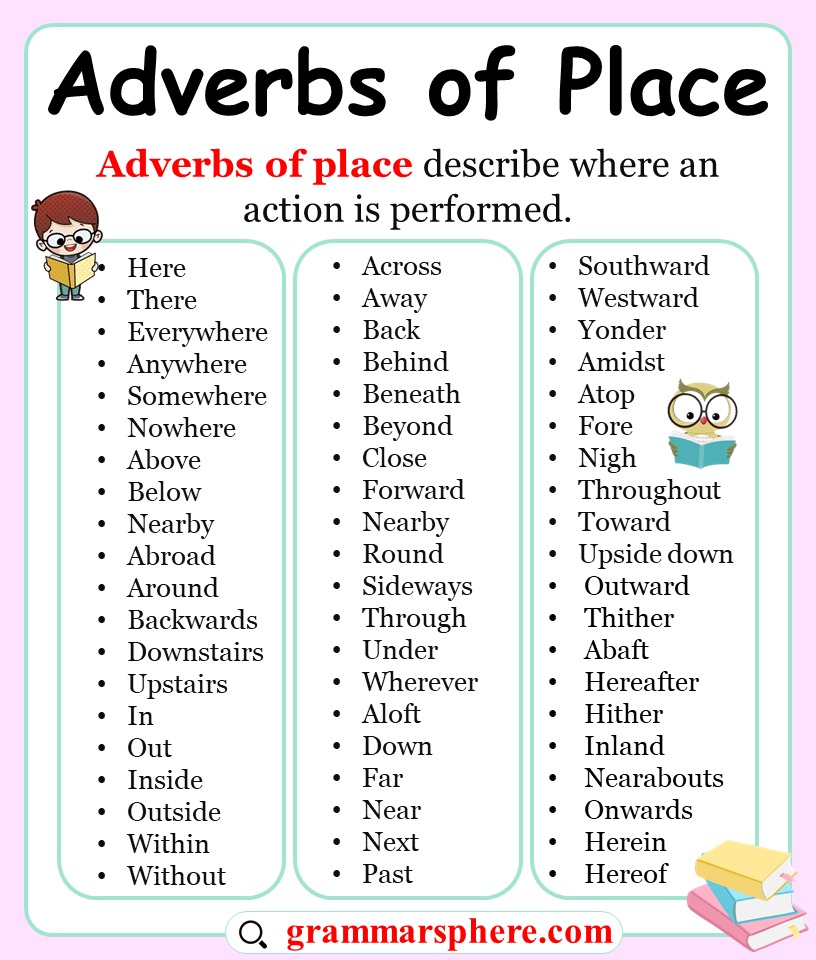
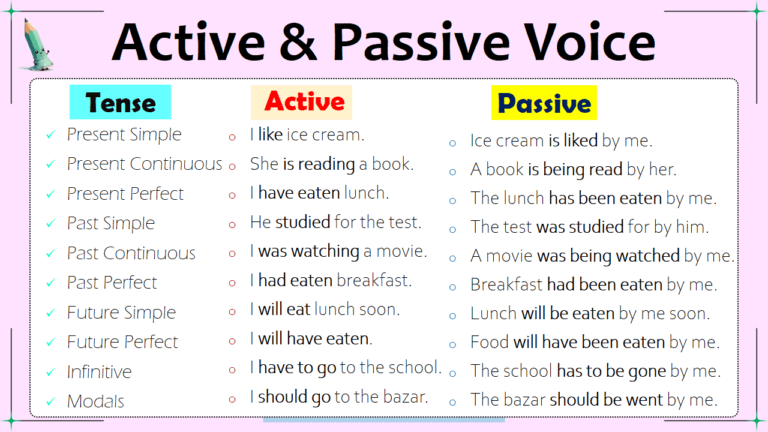
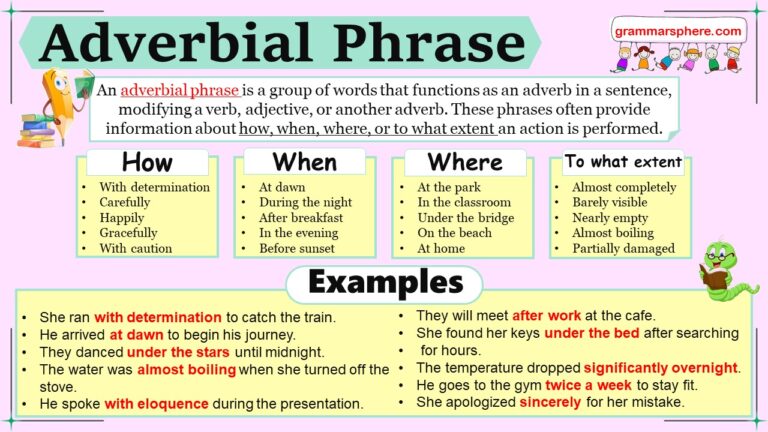
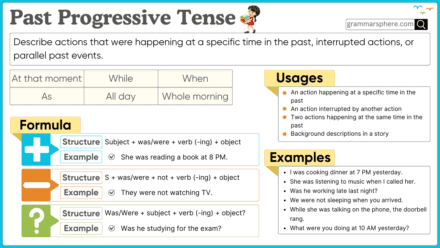

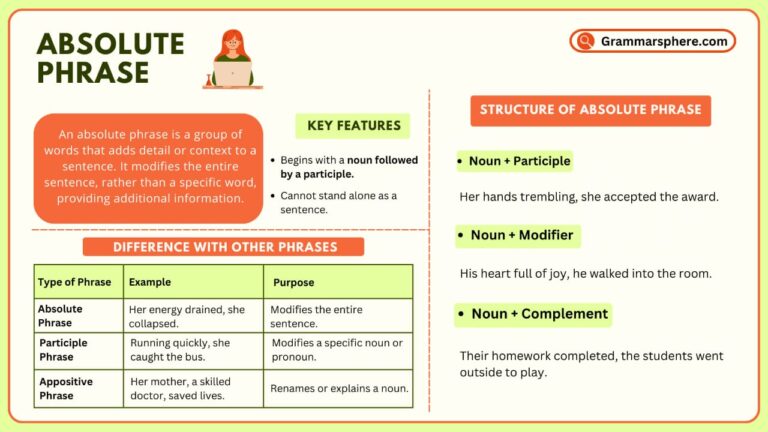
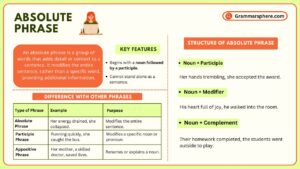
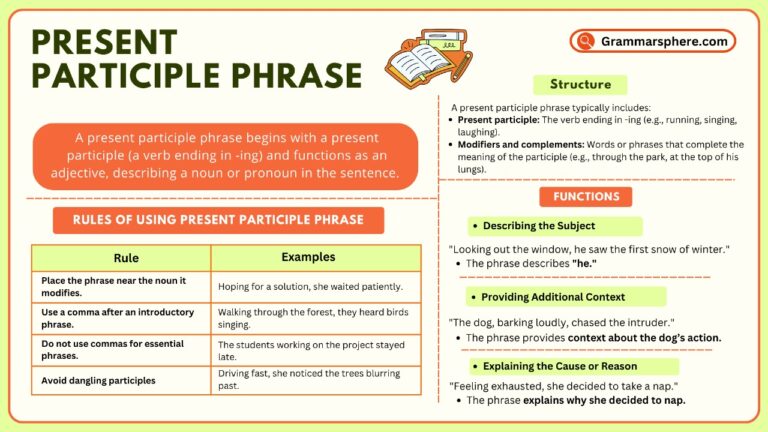

Leave a Comment